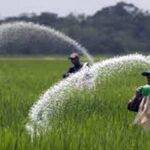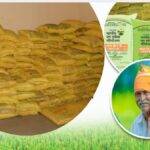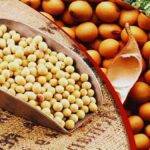Main Points In Hindi (मुख्य बातें – हिंदी में)
Certainly! Here are the main points translated into Hindi:
-
फसल चयन: कृषि वैज्ञानिकों का कहना है कि किसानों को ऐसे गेहूं की किस्में चुननी चाहिए जिनकी पैदावार अच्छी हो, पोषक तत्व अधिक हों, रोगों से लड़ने की क्षमता हो और गर्मी की लहरों को सहन कर सकें।
-
जैव-फोर्टिफाइड किस्में: सरकार जैव-फोर्टिफाइड गेहूं की किस्मों की खेती बढ़ाने पर जोर दे रही है, ताकि रोटी अधिक पोषक हो सके। इनमें प्रोटीन और जिंक की मात्रा वृद्धि की गई है।
-
ऊष्मा सहिष्णु किस्में: 2022 में गर्मी के कारण गेहूं उत्पादन पर नकारात्मक प्रभाव पड़ा था, इसलिए ऊष्मा सहिष्णु किस्मों की बुवाई अधिक फायदेमंद होगी।
-
बीज की मात्रा: बीज की मात्रा मिट्टी की स्थिति, अनाज के आकार, जर्मिनेशन, बुवाई का समय और विधि पर निर्भर करती है। उदाहरण के लिए, सिंचित क्षेत्रों के लिए समय पर बुवाई पर 100 किलोग्राम बीज प्रति हेक्टेयर पर्याप्त हैं।
- बुवाई की विभिन्न स्थितियाँ: वर्षा आधारित क्षेत्रों में समय पर बुवाई के लिए 75 किलोग्राम बीज की आवश्यकता होती है, जबकि उत्तर-पूर्वी मैदानों में 125 किलोग्राम बीज की आवश्यकता होती है।
Main Points In English(मुख्य बातें – अंग्रेज़ी में)
Here are the main points from the text about the cultivation of wheat and the emphasis on bio-fortified varieties:


-
Wheat Sowing and Selection: The sowing of wheat, the primary crop for the Rabi season, is progressing rapidly. Farmers are advised to choose wheat varieties that offer high yields, enhanced nutritional content, disease resistance, and heat tolerance.
-
Nutritional Enhancement through Bio-fortification: The government and agricultural scientists are promoting the cultivation of bio-fortified wheat varieties, which have greater nutritional properties. These varieties are designed to contain higher levels of protein (up to 13%), zinc (over 42%), and iron, aiding in combating malnutrition.
-
List of Promising Varieties: Several bio-fortified wheat varieties have been identified, including HD 3386, HD 3410, Pusa wheat 8802, and HD 3249. These varieties are noted for their increased levels of protein, zinc, and iron compared to normal wheat.
-
Heat Tolerance Importance: Due to adverse effects on wheat production from heatwaves in previous years, the cultivation of heat-tolerant wheat varieties (such as Pusa Wheat 1612 and HD 3388) is emphasized to ensure better yields under changing climatic conditions.
- Seed Requirements Based on Conditions: The seed rate varies depending on factors like soil condition and sowing time. Recommendations include 100 kg of seeds per hectare for timely sowing in irrigated areas, and 75 kg per hectare for rainfed regions, with adjustments for specific soil types and delayed sowing.
Complete News In Hindi(पूरी खबर – हिंदी में)
गीहूँ की फसल, जो रबी मौसम की मुख्य फसल है, बोने का काम तेजी से चल रहा है। कृषि वैज्ञानिक कहते हैं कि किसानों को केवल उन किस्मों का चयन करना चाहिए जो अच्छी उपज देती हैं, अधिक पौष्टिक होती हैं, बीमारियों से लड़ने में सक्षम होती हैं और गर्मी सहन कर सकती हैं। सरकार का भी ध्यान ऐसे जैव-फोर्टिफाइड गेहूँ की खेती बढ़ाने पर है, ताकि रोटी अधिक पौष्टिक बन सके। कृषि वैज्ञानिकों ने ऐसी गेहूँ की किस्में तैयार की हैं, जिनमें सामान्य गेहूँ की तुलना में अधिक पौष्टिक गुण हैं। अब गेहूँ में 13 प्रतिशत तक प्रोटीन, 42 प्रतिशत से अधिक जिंक और आयरन की मात्रा भी बढ़ गई है। ऐसे में जानिए इस लिस्ट में कौन-कौन सी किस्में शामिल हैं?
इस नाम की किस्में हैं इस सूची में
कृषि वैज्ञानिकों के अनुसार, कई जैव-फोर्टिफाइड गेहूँ की किस्में तैयार हैं। इनमें से कुछ की उपज भी अच्छी है। इनमें प्रमुख हैं: HD 3386 (प्रोटीन 11.07 प्रतिशत), HD 3410 (उच्च प्रोटीन 12.6 प्रतिशत), Pusa गेहूँ 8802 (उच्च प्रोटीन 13.3 प्रतिशत), Pusa गेहूँ 8805 (उच्च प्रोटीन 12.4 प्रतिशत और आयरन 40.4 ppm), HD 3298 (आयरन 43.1 ppm और प्रोटीन 12.12 प्रतिशत), HD 3249 (उच्च जिंक 42.5 प्रतिशत) आदि। इन सभी में सामान्य गेहूँ की तुलना में अधिक प्रोटीन, जिंक और आयरन है। चूंकि गेहूँ में जिंक, प्रोटीन और आयरन की मात्रा बढ़ती है, यह कुपोषण को नियंत्रित करने में मदद करेगा। जैव-फोर्टिफाइड बीज इस तरह से तैयार करते हैं कि उनसे होने वाली फसल अधिक पौष्टिक होती है।
गर्मी सहन करने वाली किस्में
साल 2022 में, भारत में गेहूँ उत्पादन गर्मी की लहर से प्रभावित हुआ था। ऐसे में, गर्मी सहन करने वाली गेहूँ की किस्में बोना अधिक लाभदायक होगा। इनमें प्रमुख हैं: Pusa Wheat 1612 (HI 1612), Pusa Wheat 8777 (HI 8777), HD 3293, CG 1029 (कनिष्क), DBW 327 (करण शिवानी), HD 3388, बादशाह (NWS 2194), मवन्ती (CG 1040) आदि।
यह भी पढ़ें – यह विशेष गेहूँ की किस्म बंजर भूमि में भी उगाई जा सकती है, कृषि विशेषज्ञ से जानें टिप्स
कितना बीज आवश्यक होगा?
बीज की मात्रा मिट्टी की स्थिति, अनाज के आकार, अंकुरण, बोने के समय और विधि पर निर्भर करती है। अगर अनाज का आकार बड़ा या छोटा है, तो बीज की मात्रा को उसी अनुपात में बढ़ाया या घटाया जा सकता है। सिंचित क्षेत्रों में, समय पर बोने के लिए प्रति हेक्टेयर 100 किलोग्राम बीज पर्याप्त है। देर से बोने के लिए सिंचित क्षेत्रों में 125 किलोग्राम बीज प्रति हेक्टेयर की आवश्यकता होगी।
बारिश पर निर्भर क्षेत्रों में समय पर बोने के लिए प्रति हेक्टेयर 75 किलोग्राम बीज की आवश्यकता होती है। लवणीय-आल्कलाईन मिट्टी के लिए, बीज की मात्रा 125 किलोग्राम प्रति हेक्टेयर रखनी चाहिए। इसी तरह, उत्तर-पूर्वी मैदानी क्षेत्रों (जहाँ गेहूँ धान के बाद बोया जाता है) में 125 किलोग्राम बीज प्रति हेक्टेयर की आवश्यकता है।
Complete News In English(पूरी खबर – अंग्रेज़ी में)
The work of sowing wheat, the main crop of Rabi season, is going on at a fast pace. Agricultural scientists say that farmers should choose only those varieties which have good yield, have more nutrients, have the ability to fight diseases and can withstand heat waves. The government’s emphasis is also on increasing the cultivation of bio-fortified varieties of wheat, so that bread becomes more nutritious. Agricultural scientists have prepared such varieties of wheat, which have higher nutritional properties than normal wheat. Wheat will now contain up to 13 percent protein and more than 42 percent zinc and the amount of iron has also increased. In such a situation, know which varieties are named in this list?
This name is in the list
According to agricultural scientists, many bio-fortified varieties of wheat are ready. The yield in some is also good. These varieties include HD 3386 (protein 11.07 percent), HD 3410 (high protein 12.6 percent), Pusa wheat 8802 (high protein 13.3 percent), Pusa wheat 8805 (high protein 12.4 percent and iron 40.4 ppm), HD 3298 (iron 43.1 ppm). and protein 12.12 percent), HD 3249 (high zinc 42.5 percent) etc. are prominent. All these have more protein, zinc and iron than normal wheat. Since the nutrients in wheat increase, especially zinc, protein and iron, it will help in controlling malnutrition. Biofortified seeds are prepared in such a way that the crop produced from them has more nutrients.
Heat tolerant varieties
In the year 2022, wheat production in India was adversely affected due to heat wave. In such a situation, it would be more beneficial to sow such varieties of wheat which are heat tolerant. Prominent among them are Pusa Wheat 1612 (HI 1612), Pusa Wheat 8777 (HI 8777), HD 3293, CG 1029 (Kanishka), DBW 327 (Karan Shivani), HD 3388, Badshah (NWS 2194), Mavanti (CG 1040) etc. .
Read this also – This special variety of wheat can be grown even in barren land, know tips from agriculture expert
How much seed will be required?
Seed rate depends on soil condition, grain size, germination, time of sowing and sowing method. If the size of the grains is big or small then the seed rate can be increased or decreased in the same proportion. Similarly, in irrigated areas, 100 kg seed per hectare is sufficient for timely sowing. For late sowing in irrigated areas, 125 kg seeds per hectare are required.
For timely sowing in rainfed areas, 75 kg of seeds per hectare is required. For saline alkaline soil, the seed rate should be kept at 125 kg per hectare. Similarly, for the north-eastern plains (where wheat is sown after paddy), 125 kg seeds per hectare are required.










